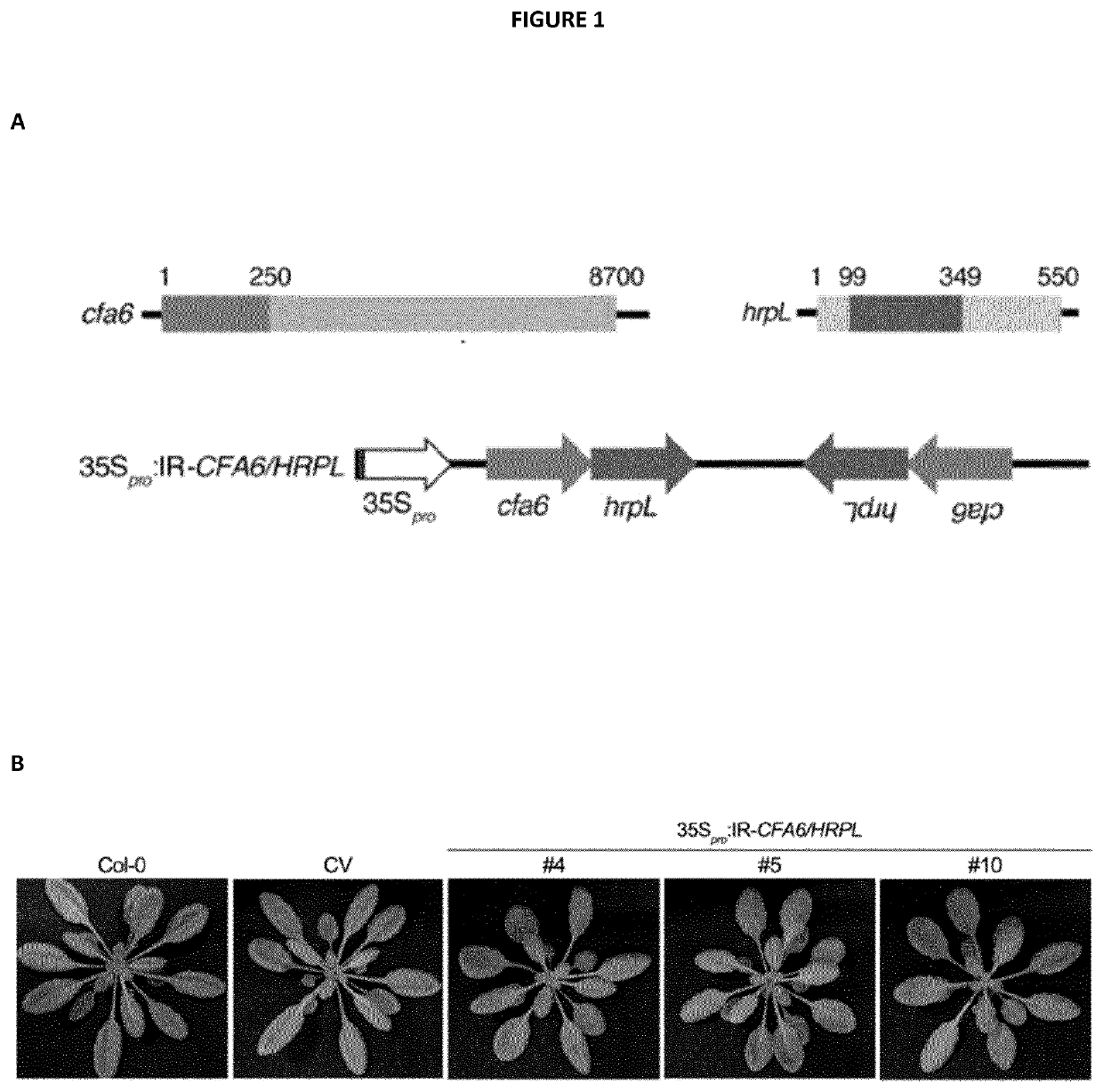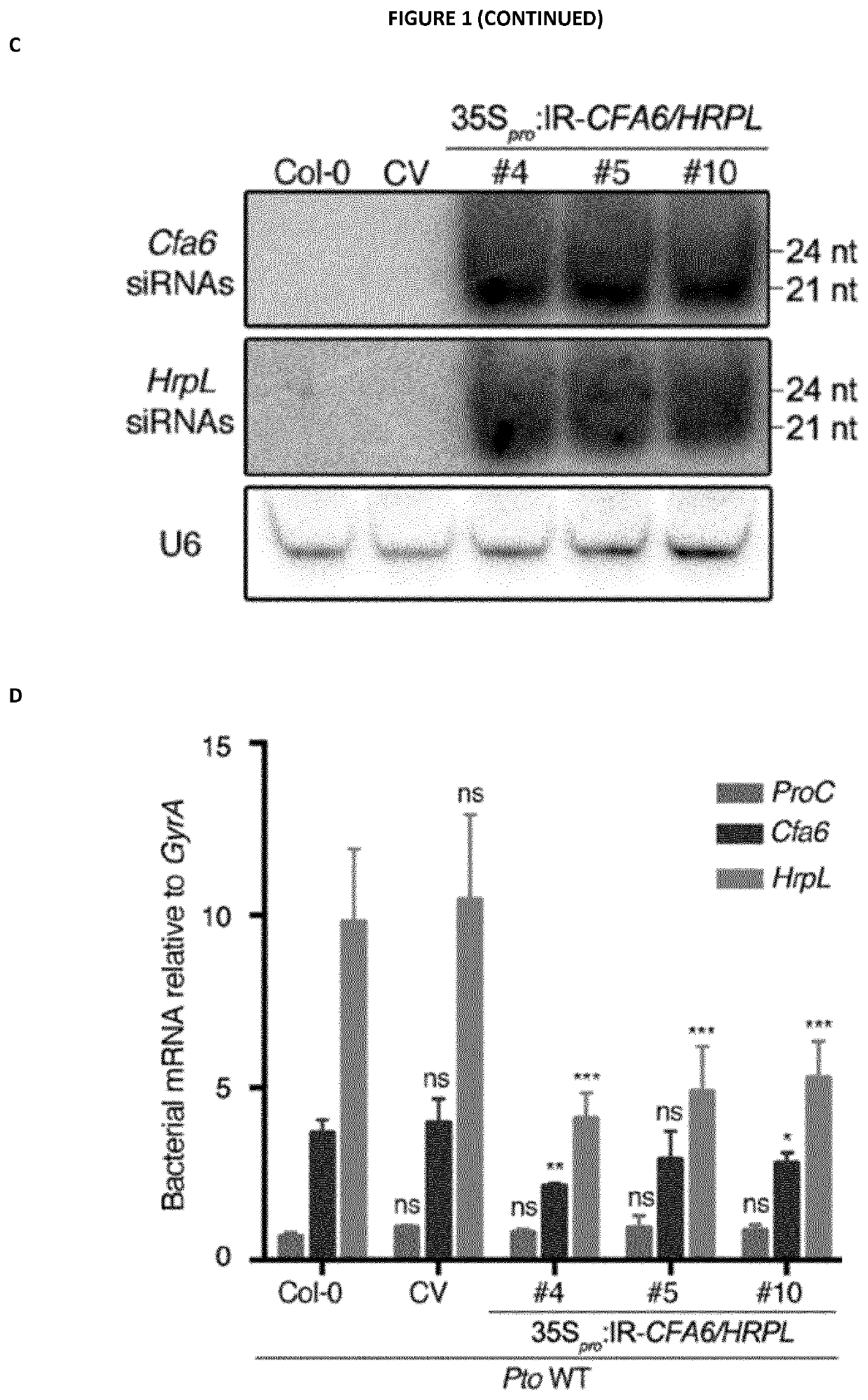Rna-based biocontrol methods to protect plants against pathogenic bacteria and / or promote beneficial effects of symbiotic and commensal bacteria
a biocontrol method and rna technology, applied in the field of agriculture, can solve the problems of significant economic losses worldwide, limited sigs/sigs technology, and insufficient utilization of rna-based silencing technologies to protect plants from bacterial pathogens, etc., to achieve efficient capture, dampen bacterial pathogenicity and growth, and affect bacterial growth
- Summary
- Abstract
- Description
- Claims
- Application Information
AI Technical Summary
Benefits of technology
Problems solved by technology
Method used
Image
Examples
example 1
and Methods
Generation of Transgenic Lines Carrying Inverted Repeats Constructs
[0276]The IR-CFA6 / HRPL chimeric hairpin was designed to produce artificial siRNAs targeting a 250 bp region of Cfa6 (from nucleotide 1 to 250) and a 250 bp region of HrpL from nucleotide 99 to 348 (SEQ ID NO: 1, 2 and 3). The IR-CFA6-A and IR-CFA6-B are two independent inverted repeats that specifically target the Cfa6 gene from nucleotide 1 to 250 (SEQ ID NO: 4, 2 and 5) and from nucleotide 1 to 472 (SEQ ID NO: 6, 2 and 7), respectively. The IR-HRPL-A and IR-HRPL-B are two independent inverted repeats that specifically target HrpL from nucleotide 99 to 348 (SEQ ID NO: 8, 2 and 9) and from nucleotide 1 to 348 (SEQ ID NO: 10, 2 and 11), respectively. The IR-HRCC hairpin was designed to specifically target the HrcC gene (SEQ ID NO: 12, 2 and 13) and the IR-AvrPto / AvrPtoB to concomitantly target the type III effector AvrPto and AvrPtoB genes (SEQ ID NO: 14, 2 and 15). The IR-CYP51 hairpin was designed to prod...
example 3
ded siRNAs Directed Against Cfa6 and HrpL Prevent Pto DC3000-Induced Stomatal Reopening Presumably by Suppressing Coronatine Biosynthesis
[0296]Because Cfa6 and HrpL are known to regulate each other (53) and because HrpL and Cfa6 are both essential for coronatine (COR) biosynthesis (52, 53), we next investigated whether IR-CFA6 / HRPL plants could be protected from COR-dependent virulence responses. For this purpose, we monitored Pto DC3000-triggered stomatal reopening at 3 hours post-inoculation (3 hpi), a phenotype that is fully dependent on COR biosynthesis and thus abolished upon inoculation with Pto DC3000 mutants that are either deleted in Cfa6 or HrpL genes (FIG. 3A, (50)). It is noteworthy that this phenotype is not dependent on type III effectors at this timepoint of infection because a normal stomatal reopening response was observed upon treatment with the Pto DC3000 hrcC mutant (FIG. 3A, (50)), which is impaired in the assembly of the type III secretion system. Significantly...
example 6
Species, but not their dsRNA Precursors, are Causal for the Compromised Stomatal Reopening Phenotype Observed Upon Exogenous Application of Total RNAs Derived from the IR-CFA6 / HRPL Hairpin
[0300]Next, we interrogated which RNA entities are responsible for AGS and pathogenesis reduction upon external application of antibacterial RNAs. To address this question, we first crossed the IR-CFA6 / HRPL #4 reference line with the dcl2-1 dcl3-1 dcl4-2 (dcl234) triple mutant and subsequently selected F3 plants that were homozygous for the three dcl mutations and for the IR-CFA6 / HRPL transgene. Molecular characterization of these IR-CFA6 / HRPL #4×dcl234 plants revealed an enhanced accumulation of IR-CFA6 / HRPL inverted repeat transcripts (i.e. unprocessed dsRNAs) compared to the level detected in IR-CFA6 / HRPL #4 parental line (FIG. 7A). Furthermore, this effect was associated with undetectable levels of anti-Cfa6 and anti-HrpL siRNAs (FIG. 7A). These data are thus consistent with a role of DCL2, DCL...
PUM
| Property | Measurement | Unit |
|---|---|---|
| time | aaaaa | aaaaa |
| pH | aaaaa | aaaaa |
| size | aaaaa | aaaaa |
Abstract
Description
Claims
Application Information
 Login to View More
Login to View More - R&D
- Intellectual Property
- Life Sciences
- Materials
- Tech Scout
- Unparalleled Data Quality
- Higher Quality Content
- 60% Fewer Hallucinations
Browse by: Latest US Patents, China's latest patents, Technical Efficacy Thesaurus, Application Domain, Technology Topic, Popular Technical Reports.
© 2025 PatSnap. All rights reserved.Legal|Privacy policy|Modern Slavery Act Transparency Statement|Sitemap|About US| Contact US: help@patsnap.com



